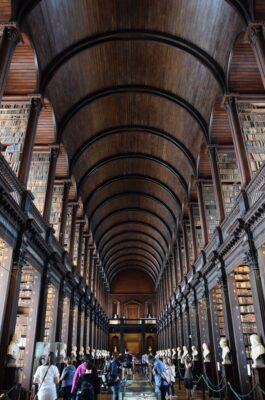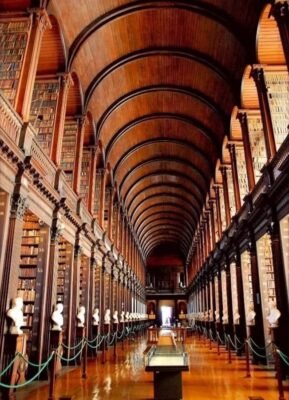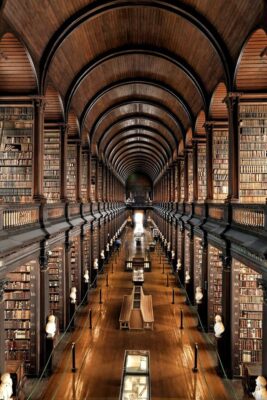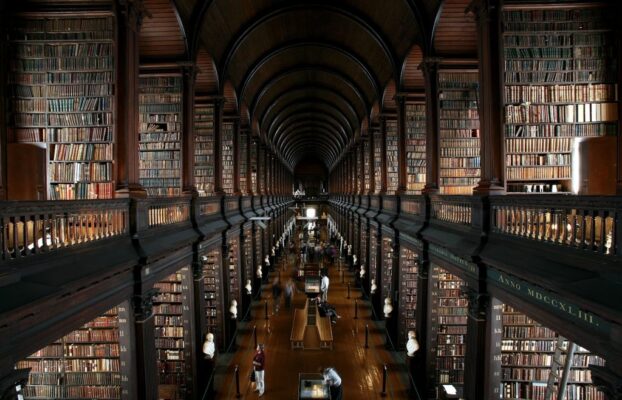The Long Room in the Library at Trinity College in Dublin, Ireland, stands as a beacon of history, knowledge, and architectural brilliance. Built between 1712 and 1732, this iconic space has captivated visitors from around the world with its grandeur and scholarly ambiance. Follow archeology.dulichvn.net to discover many hidden mysteries that have yet to be discovered.

The History Behind the Long Room
Construction and Purpose: A Vision of Knowledge Preservation
The Long Room at Trinity College was conceived as a monumental repository to house the institution’s expanding collection of books and manuscripts. Constructed between 1712 and 1732, the creation of this iconic library space was a testament to the foresight and dedication of its founders. They recognized the need for a sanctuary of learning, where the written word could be safeguarded and studied for generations to come.
Every detail of the Long Room’s construction reflects careful planning and an unwavering commitment to the preservation of knowledge. The grand design was not merely functional but also symbolic, representing the intellectual aspirations of Trinity College as a center of scholarship in Ireland and beyond.
Expanding Knowledge: Adapting to Growth
Originally, the Long Room featured a simpler design with a flat plaster ceiling and a single gallery. However, as the library’s collection grew exponentially over the decades, it became evident that the space needed to evolve.
In the mid-19th century, a major renovation transformed the Long Room into the awe-inspiring space it is today. The addition of a barrel-vaulted ceiling not only enhanced the architectural grandeur but also improved the acoustics, creating a serene and scholarly atmosphere. An upper gallery was constructed to accommodate more shelves, effectively doubling the library’s storage capacity. This adaptation ensured that the Long Room could continue to serve as a functional and inspirational space for future generations.
A Repository of Treasures: Ireland’s Literary and Historical Gems
The Long Room is more than just a library; it is a treasure trove of Ireland’s most precious artifacts. Among its holdings is the legendary Book of Kells, a 9th-century illuminated manuscript celebrated for its intricate artwork and historical significance. This masterpiece, displayed in a dedicated exhibition, attracts visitors from across the globe.
Another priceless artifact housed in the Long Room is the Brian Boru harp, a national symbol of Ireland. This ancient instrument, dating back to the Middle Ages, holds a special place in Irish heritage and is said to have inspired the design of the national emblem.
In addition to these iconic items, the Long Room’s shelves are lined with over 200,000 of the library’s oldest books, many of which are rare and irreplaceable. These volumes span a wide array of subjects, from theology and philosophy to science and literature, offering a glimpse into the intellectual pursuits of centuries past.
Together, these treasures make the Long Room a living museum, where Ireland’s cultural and historical legacy is preserved and celebrated. Visitors leave with a profound appreciation for the enduring power of knowledge and the stories that these ancient artifacts continue to tell.

Architectural Splendor of the Long Room
The Barrel-Vaulted Ceiling: A Masterpiece of Design
The barrel-vaulted ceiling of the Long Room is one of its most defining and enchanting features. Rising high above the towering shelves, this architectural marvel gives the library an ethereal quality, amplifying its grandeur. Designed during the 19th-century renovation, the ceiling not only elevates the visual impact of the space but also enhances its acoustics, creating a serene and contemplative atmosphere for visitors.
The curvature of the ceiling draws the eye upward, evoking a sense of infinite space that mirrors the boundless pursuit of knowledge. Its intricate wooden framework, crafted with precision, reflects the skill and artistry of the craftsmen who brought this vision to life.
Endless Rows of Shelves: Guardians of Knowledge
Stretching from floor to ceiling, the oak shelves of the Long Room stand as silent guardians of history and knowledge. These meticulously crafted shelves hold over 200,000 of Trinity College’s oldest and rarest books, spanning centuries of human thought and discovery.
The symmetry of the rows creates a visual harmony that instills a sense of order and timelessness. Each book, carefully preserved, represents a fragment of the past—a testament to the enduring power of the written word. Walking among these shelves, visitors are transported through time, surrounded by the collective wisdom of generations.
The dark oak wood, polished to a soft sheen over centuries, contrasts beautifully with the natural light filtering through the room’s tall windows, further enhancing the space’s majestic ambiance.
Marble Busts: A Tribute to Great Minds
Dotted throughout the Long Room are marble busts of some of history’s most influential thinkers, writers, and scholars. These sculptures, commissioned in the 18th century, serve as a tribute to the intellectual giants who have shaped the course of human understanding.
Among the illustrious figures immortalized in marble are Aristotle, the father of Western philosophy; Socrates, the pioneer of critical inquiry; and Jonathan Swift, the celebrated Irish author and satirist. Each bust is masterfully carved, capturing the essence of these legendary minds.
The placement of the busts along the aisles creates a profound connection between the ideas preserved in the books and the individuals who conceived them. As visitors stroll through the Long Room, they are reminded of the profound impact of these figures on human progress, their likenesses standing watch over the treasures of the past.
These three elements—the barrel-vaulted ceiling, endless shelves, and marble busts—combine to make the Long Room not only a repository of knowledge but also a sanctuary of inspiration and reverence for human achievement.

Experiencing the Long Room
Stepping into History
Entering the Long Room is akin to walking through a portal into the past. The moment you step inside, you’re enveloped by an aura of quiet reverence, as if the very walls hold their breath in respect for the centuries of history and knowledge they house. Each step along the polished wooden floors echoes with the whispers of scholars and students who have traversed this sacred space before.
The air carries a faint scent of aged paper and oak, evoking nostalgia and a deep connection to a bygone era. Visitors can almost feel the weight of history pressing gently upon their shoulders, as the towering shelves and intricate details of the room tell stories of countless generations dedicated to the pursuit of wisdom.
Capturing Timeless Beauty
The Long Room is a haven for photographers and artists seeking inspiration. Its breathtaking interplay of light and shadow transforms every angle into a masterpiece. Tall arched windows allow streams of natural light to filter in, illuminating the golden hues of aged paper and the rich, dark tones of oak.
The symmetry of the shelves, the gentle curve of the barrel-vaulted ceiling, and the timeless allure of marble busts create an enchanting visual tableau. Whether through the lens of a camera or the strokes of a brush, the Long Room’s aesthetic is a testament to the enduring beauty of craftsmanship and design.
This iconic space doesn’t just invite visitors to capture its beauty—it challenges them to see the harmony between art, history, and architecture. Every photograph taken or sketch drawn becomes a tribute to the room’s unparalleled charm.
A Sanctuary for Book Lovers
For bibliophiles, the Long Room transcends its role as a library—it becomes a sanctuary of literary devotion. Each book, carefully preserved and proudly displayed, represents a piece of human history, a fragment of thought immortalized in ink and paper.
As visitors wander through the aisles, they’re struck by a profound appreciation for the written word. The quiet hum of the space fosters introspection and inspires a deeper connection to literature. From the weathered spines of ancient tomes to the stories etched into their pages, every element of the Long Room speaks to the transformative power of books.
For book lovers, the experience of being in the Long Room is both humbling and uplifting. It’s a reminder that literature not only reflects the past but also shapes the future, urging us to cherish and protect this invaluable legacy.

Practical Information for Visitors
Admission and Guided Tours
Access to the Long Room is a highlight of guided tours that include the renowned Book of Kells exhibition at Trinity College. These tours provide valuable insights into the history and significance of the library, enriching the visitor experience. Due to its immense popularity, pre-booking tickets online is strongly recommended to secure your preferred time slot and avoid long queues.
Tour guides are often passionate experts who bring the Long Room to life through fascinating anecdotes and historical context. They provide a deeper understanding of the treasures housed within and the architectural marvels of this iconic space.
Best Time to Visit
For a truly magical experience, plan your visit during the early morning or late afternoon. During these quieter hours, the Long Room takes on an almost ethereal quality, with soft light streaming through its arched windows, illuminating the aged paper and rich woodwork.
Avoiding peak times not only ensures a more serene atmosphere but also allows for uninterrupted moments to admire the intricate details and take photographs without the bustle of crowds. Seasonal considerations also play a role—visiting in spring or autumn adds an extra layer of charm, as the surrounding Trinity College campus is particularly vibrant during these times.
Tips for Visitors
- Comfortable Footwear: Exploring the historic Trinity College campus requires a fair bit of walking. Sturdy, comfortable shoes will make your visit more enjoyable as you navigate its cobblestone paths and staircases.
- Bring a Camera: The Long Room’s breathtaking beauty deserves to be captured. A good-quality camera or smartphone ensures you can preserve the memory of this enchanting space. Be sure to check for any photography restrictions before your visit.
- Extend Your Exploration: Don’t limit yourself to the library alone. Nearby, you’ll find the iconic campanile, a beloved symbol of Trinity College, and beautifully maintained gardens perfect for a leisurely stroll or a moment of reflection.

Preserving the Legacy
Conservation Efforts: Preserving a Timeless Legacy
The conservation of the Long Room at Trinity College Library is an ongoing endeavor, meticulously carried out to protect both its architectural grandeur and invaluable literary treasures. The library’s dedicated staff employs advanced preservation techniques to ensure the room’s historic integrity and its collection remain intact for generations to come.
Environmental controls are a crucial part of these efforts, with careful monitoring of temperature, humidity, and light levels to prevent damage to the ancient books and delicate woodwork. Regular maintenance of the structure, including its iconic barrel-vaulted ceiling and towering oak shelves, ensures the Long Room continues to inspire awe in all who visit.
Digital Archives: Bringing History to the World
In a bid to make the library’s rich collection accessible to a global audience, Trinity College has undertaken an ambitious digitization project. Rare manuscripts, ancient texts, and iconic works, including the treasured Book of Kells, are being carefully scanned and preserved as high-resolution digital files.
This initiative not only extends the reach of these priceless artifacts but also safeguards their content from potential physical degradation. Scholars, researchers, and enthusiasts from around the world can now explore the library’s treasures remotely, fostering a deeper appreciation of its cultural and historical significance.
A Cultural Icon: Ireland’s Beacon of Knowledge
The Long Room is more than a repository of books—it stands as a symbol of Ireland’s enduring commitment to the pursuit of knowledge, the preservation of history, and the celebration of artistic achievement. Its towering shelves and marble busts serve as a testament to the intellectual giants who have shaped human understanding.
Beyond its academic significance, the Long Room has become a cultural icon, frequently featured in films, literature, and art. It represents the spirit of discovery and reverence for learning that continues to inspire visitors from around the globe. Through its conservation efforts and digital outreach, the library ensures this timeless landmark remains a beacon of knowledge and heritage for centuries to come.
See more: The Unexpected Find After Pulling Down a False Wall in a 1857 House: Discovering Hidden History
Conclusion
The Long Room at Trinity College is a must-visit destination for anyone passionate about history, architecture, and literature. Its rich legacy, architectural brilliance, and unparalleled collection of treasures make it a timeless symbol of human achievement and a testament to the enduring power of knowledge.


CÁC TIN KHÁC
Mary Walton: The Forgotten Inventor Who Helped Clean Up America’s Cities
Tomb of Queen Nefertari in the Valley of the Queens, Egypt
Discover the Hypostyle Hall of the Temple of Hathor at Dendera
Venus de Losange: Unveiling the Mystery of a 20,000-Year-Old Paleolithic Icon